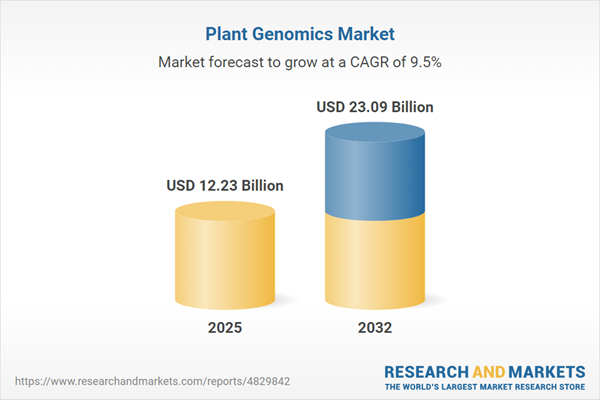Speak directly to the analyst to clarify any post sales queries you may have.
Plant genomics is reshaping strategic priorities for organizational leaders seeking to secure resilient food systems, adapt agricultural operations, and embrace next-generation biotechnology. As advancements accelerate, the landscape offers both operational challenges and new opportunities for value creation.
Market Snapshot: Plant Genomics Market Size, Growth, and Opportunities
The plant genomics market expanded from USD 11.16 billion in 2024 to USD 12.23 billion in 2025 and is projected to increase at a CAGR of 9.50%, achieving USD 23.09 billion by 2032. Growth drivers include heightened demand for genomic solutions capable of addressing global food security complexities, rising adoption of precision agriculture, and the convergence of gene editing and sequencing platforms. The competitive landscape is shaped by aggressive investment from established players, new market entrants, and regulatory adjustments affecting supply chains and procurement initiatives.
Scope & Segmentation
This report delivers an in-depth review of the plant genomics sector, covering technological, service, application, and regional dynamics relevant to strategic planning. Segmentation spans principal industry categories and highlights key convergence areas:
- Product Types: Instruments employed for genomic analysis, reagents and consumables vital for research, comprehensive services catering to operational support, and specialized software facilitating data management.
- Technologies: Innovative gene editing tools such as Crispr, transcription activator-like effector nucleases, and zinc finger nucleases, along with polymerase chain reaction in multiple formats (digital, quantitative, reverse transcription) and advanced sequencing technologies (next-generation, Sanger, third-generation).
- Service Models: Consulting for solution planning, contract research outsourcing, and data analysis services designed to meet complex organizational needs.
- Applications: Deployment in agriculture for boosting disease resistance, facilitating yield improvement, and advancing crop genetics; use in diagnostics for genetic and infectious disease testing as well as prenatal evaluation; and in research for discovery and biomarker identification.
- End Users: Key stakeholders such as academic and research institutes, major agriculture firms, hospitals and diagnostic laboratories, along with pharmaceutical and biotechnology companies influencing market uptake.
- Regions Covered: Broad global scope across the Americas (including the United States, Canada, and several Latin American countries), Europe/Middle East/Africa (markets across Western and Eastern Europe, Middle East, and Africa), and Asia-Pacific (major economies such as China, India, Japan, Australia, and Southeast Asia).
- Companies Featured: Industry leaders including Illumina, Thermo Fisher Scientific, BGI Genomics, QIAGEN, Agilent Technologies, PerkinElmer, Pacific Biosciences, Oxford Nanopore Technologies, Eurofins Scientific, and Merck KGaA.
Key Takeaways for Senior Decision-Makers
- High-throughput sequencing and advanced gene editing technologies are driving new standards in crop development and elevating the capability of agricultural value chains.
- The application of AI and machine learning in genomics facilitates intelligent trait selection and predictive breeding, fostering competitive differentiation.
- Partnerships among technology providers, public-sector bodies, and private enterprises are promoting data sharing, accelerating innovation, and expanding resource accessibility for stakeholders.
- Compliance requirements are evolving, particularly in EMEA and Asia-Pacific, necessitating stronger alignment between market players and policymakers to accommodate new regulations.
- Service and software offerings are seeing robust growth among research institutes and laboratories, highlighting an increasing demand for advanced informatics and outsourced research solutions.
- Emerging regions are ramping up investments in local capabilities, opening the door for customized solutions tailored to specific environmental and food security needs.
Tariff Impact: Navigating Regulatory and Supply Chain Disruptions
The introduction of new United States tariffs in 2025 has elevated costs and extended procurement timelines for sectors reliant on specialized reagents, instruments, and digital solutions. Procurement executives are mitigating risks by pursuing multiple sourcing channels and expanding domestic production. Forging closer relationships with regional suppliers is proving central to maintaining supply chain continuity and research momentum for both agricultural and biotechnology stakeholders.
Methodology & Data Sources
The analysis leverages a robust approach involving direct interviews with sector professionals—including R&D leaders, procurement decision-makers, and policymakers—combined with extensive reviews of peer-reviewed literature, industry papers, regulatory and patent filings, and company disclosures. Data triangulation and expert validation underpin the accuracy and relevance of the study.
Why This Report Matters
- Empower strategic investment, partnership, and new product decisions with actionable insights based on emerging trends and data-driven market intelligence.
- Equip executive teams with targeted knowledge on segment-specific dynamics, regional growth considerations, and novel technologies to inform agile business planning.
- Address the challenges of geopolitical shifts and supply chain disruptions with clear guidance on market adaptation and risk management strategies.
Decision-makers are enabled to anticipate change, minimize operational risks caused by tariffs, and leverage emerging opportunities across global plant genomics networks.
Conclusion
Plant genomics is entering a pivotal period of innovation and global alignment. Senior executives who draw on these findings can drive resilient growth and ensure sustainable transformation throughout their organizations.
Additional Product Information:
- Purchase of this report includes 1 year online access with quarterly updates.
- This report can be updated on request. Please contact our Customer Experience team using the Ask a Question widget on our website.
Table of Contents
3. Executive Summary
4. Market Overview
7. Cumulative Impact of Artificial Intelligence 2025
Companies Mentioned
The companies profiled in this Plant Genomics market report include:- Illumina, Inc.
- Thermo Fisher Scientific Inc.
- BGI Genomics Co., Ltd.
- QIAGEN N.V.
- Agilent Technologies, Inc.
- PerkinElmer, Inc.
- Pacific Biosciences of California, Inc.
- Oxford Nanopore Technologies Limited
- Eurofins Scientific SE
- Merck KGaA
Table Information
| Report Attribute | Details |
|---|---|
| No. of Pages | 198 |
| Published | October 2025 |
| Forecast Period | 2025 - 2032 |
| Estimated Market Value ( USD | $ 12.23 Billion |
| Forecasted Market Value ( USD | $ 23.09 Billion |
| Compound Annual Growth Rate | 9.5% |
| Regions Covered | Global |
| No. of Companies Mentioned | 11 |









